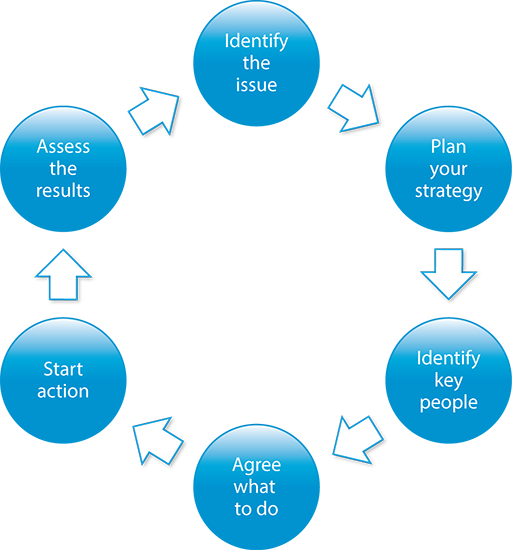3.5 The action cycle of community mobilisation
Once you are familiar with the community, you can explore the health issues and child rights issues and why any specific problems are occurring. You should look for helpful or harmful health practices, beliefs, attitudes and knowledge within that community that are related to the health problem under consideration. Once the health issues are fully explored, you can set priorities, develop a more detailed plan of work and carry out the plan. During implementation of the programme, you should monitor and finally evaluate your activities (Module 5 has more information on monitoring and evaluation). Before starting a community mobilisation strategy, it can be helpful to think of the required activities in the form of a cycle (Figure 3.4). This is because as a health provider, you should start the mobilisation process by clearly setting the goal of the action and the steps to achieve it in your mind, then organise and plan the work with the community.

Here is an example of community mobilisation:
Step 1 Identify a significant health problem, for example, early marriage. You might already have ideas from your own experience as a health worker, or you might want to work with other members of the community, including children, to explore ideas.
Step 2 Plan and select a strategy to solve the problem. You will need to think about the causes of the problem and try to develop a plan to tackle those causes. You might do this by organising a workshop with key local people to explore what needs to change and how you might go about it.
Step 3 Identify key people and stakeholders. You need to involve as many people as possible from the community who are likely to be interested in the issue. But you also need to think about who are the influential people in the community who have the power to make change happen – for example, the local council chairperson, MP, cultural and religious leaders.
Step 4 Mobilise these key people and stakeholders for action. Engage them in discussions about possible activities and get agreement from everyone as to the commitments they are prepared to make.
Step 5 Implement activities to work towards a solution. You will need to follow up the commitments with action and have regular meetings to see what progress is being made.
Step 6 Assess the results of the activities carried out to solve the problem.
Step 7 Improve activities, based on the findings of the assessment. Following any community health activities, you should always get community members to participate in checking how well the activity went. Discuss the results with the community and in that way you can help them to learn. If they know why progress was achieved, or an action succeeded or failed, they will be able to make better efforts next time. If the programme seems successful, you should think about how you could scale up that method to a larger number of households. In this way, the action continues.
3.4 Knowing your community
